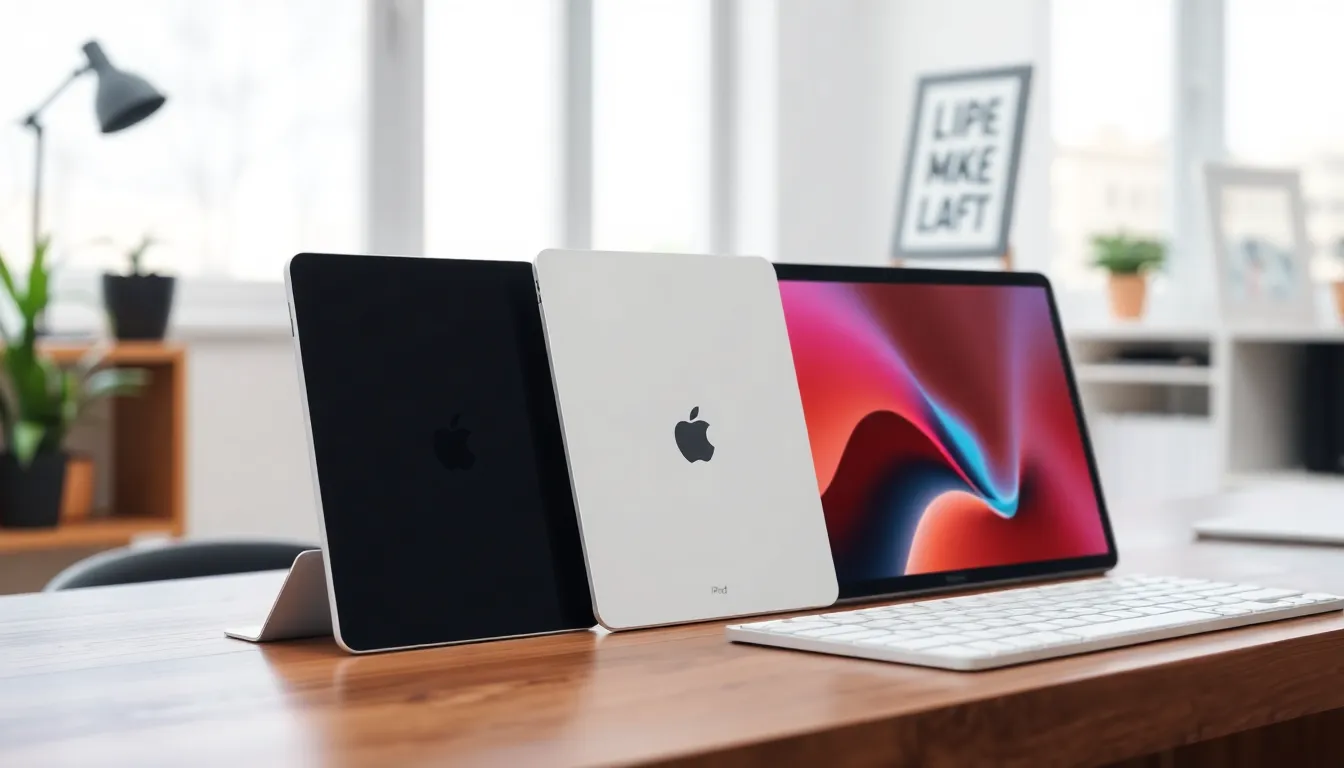When it comes to choosing an iPad, it’s like picking a favorite child—each one has its own quirks and charm. Apple’s lineup can feel overwhelming, but don’t worry, it’s not rocket science. Whether you’re a casual browser, a budding artist, or a professional on the go, there’s an iPad tailored just for you.
Table of Contents
ToggleOverview Of iPad Models
Apple offers several iPad models, each designed to cater to different needs and preferences. With various sizes and capabilities, understanding these differences helps users choose the right device.
The iPad Basic serves as an excellent entry-level option. It features a 10.2-inch display and supports the first-generation Apple Pencil, making it suitable for students and casual users.
The iPad Air stands out with its lightweight design and powerful performance. Equipped with a 10.9-inch Liquid Retina display, it supports the second-generation Apple Pencil and can handle professional tasks effectively.
The iPad Pro offers the most advanced features in Apple’s lineup. It comes in 11-inch and 12.9-inch sizes, with ProMotion technology for a smoother viewing experience. This model is ideal for creatives who require high performance and visual fidelity.
The iPad Mini is a compact alternative, featuring a 7.9-inch display. Its size makes it highly portable, perfect for reading and browsing on the go. Despite its smaller dimensions, it still boasts impressive power and supports the second-generation Apple Pencil.
Pricing varies significantly among models, starting from around $329 for the iPad Basic to over $1,099 for the larger iPad Pro configurations. Each iPad model offers unique capabilities that meet diverse user preferences, making the selection process clear and straightforward.
Understanding specifications, display sizes, and performance benchmarks enables potential buyers to make informed decisions. With this overview, exploring the distinct characteristics of each iPad model helps simplify the selection.
Key Differences Between iPads

The differences between iPad models are essential for potential buyers. Understanding size, display technology, and performance ensures the right choice.
Size And Weight Comparisons
iPad models vary in size and weight significantly. The iPad Mini measures 7.9 inches and weighs just 0.66 pounds, making it highly portable. In contrast, the iPad Pro starts at 11 inches, with the larger model reaching 12.9 inches and weighing 1.5 pounds. The iPad Basic offers a middle ground at 10.2 inches and weighs around 1.08 pounds, balancing portability with usability. Aspiring users can select based on personal comfort and use cases.
Display Technology Variations
Display technology distinguishes the iPad lineup. The iPad and iPad Mini feature Retina displays, offering a resolution of 2160 x 1620 pixels. For enhanced visuals, the iPad Air features Liquid Retina technology. ProMotion technology shines in the iPad Pro, delivering a 120Hz refresh rate, ideal for creatives and gamers alike. Buyers should assess their visual needs, whether they prefer basic functionality or advanced display performance.
Performance And Specifications
Performance specifications set each iPad apart. The iPad Basic runs on the A13 Bionic chip, providing sufficient power for everyday tasks. In contrast, the iPad Air utilizes the A14 chip, facilitating smoother multitasking and high-performance applications. The iPad Pro elevates performance further with the M1 chip, allowing seamless productivity and creativity. Individual requirements determine the best choice, especially for users with demanding applications.
iPadOS Features
iPadOS enhances the iPad experience through unique capabilities tailored for each model. Users frequently discover that these features significantly improve their productivity and enjoyment.
Unique Features for Each Model
iPad Basic offers essential tools for casual use, including robust multitasking and a family-sharing option. Users can enjoy features like Split View and Slide Over, which enhance multitasking capabilities. iPad Air provides advanced features such as the Apple Pencil support for creative tasks and an A14 Bionic chip for smooth performance. iPad Pro stands out with ProMotion technology, delivering a 120Hz refresh rate for seamless navigation and a Liquid Retina display for vibrant visuals. With its compact size, iPad Mini preserves powerful features while providing ultimate portability for reading and browsing. Combining these elements allows different users to maximize the device’s potential according to their needs.
Software Compatibility
iPadOS ensures software compatibility across all iPad models while introducing unique features. Each device supports the latest iPadOS updates, ensuring security and performance improvements. Multitasking capabilities are consistent across models, enabling users to work efficiently. Improved app management further enhances the experience, particularly for professionals using the iPad Pro. Features like redesigned homescreens and widget support make customization easy. Users of iPad Air can leverage features like the Magic Keyboard to enhance productivity. Overall, software compatibility offers a cohesive experience, bringing out the best in each iPad model while meeting diverse user requirements.
Price And Value Analysis
Pricing varies significantly among iPad models, making understanding the value proposition essential. The iPad Basic starts at approximately $329, making it an affordable choice for students and casual users. For a moderate price increase, the iPad Air begins around $599, offering a balance of power and portability suitable for various tasks.
Higher-end configurations, such as the iPad Pro, command prices starting at $799 and can exceed $1,099 for larger storage options. Premium features justify the price point for professionals, especially those requiring advanced performance and display technology.
Each model aligns with specific user needs, influencing the overall value. The iPad Mini, priced around $499, delivers exceptional portability, making it a favorite for reading or browsing on the go. Users seeking a lightweight device may find this option highly appealing.
Investing in the right iPad requires evaluating individual needs against available features. Essential tasks can be efficiently managed with the iPad Basic, while more demanding applications benefit from the processing power of the iPad Air and iPad Pro.
When considering value, performance specifications come into play. The iPad Basic operates on the A13 Bionic chip, providing sufficient speed for everyday use. Users needing more robust capabilities will appreciate the A14 chip in the iPad Air or the powerful M1 chip found in the iPad Pro.
Software compatibility enhances the value across all models, ensuring users receive updates and security improvements without needing to change devices frequently. Overall, understanding the pricing structure and value of each iPad model aids in making informed choices tailored to specific requirements.
Navigating the iPad lineup can be a rewarding experience when users understand the unique strengths of each model. Whether it’s the affordability of the iPad Basic or the high-end capabilities of the iPad Pro, there’s an option for everyone.
By considering individual needs and preferences, potential buyers can confidently choose an iPad that aligns with their lifestyle. The right device not only enhances productivity but also enriches everyday experiences. With the right information in hand, selecting the perfect iPad becomes a straightforward journey.



